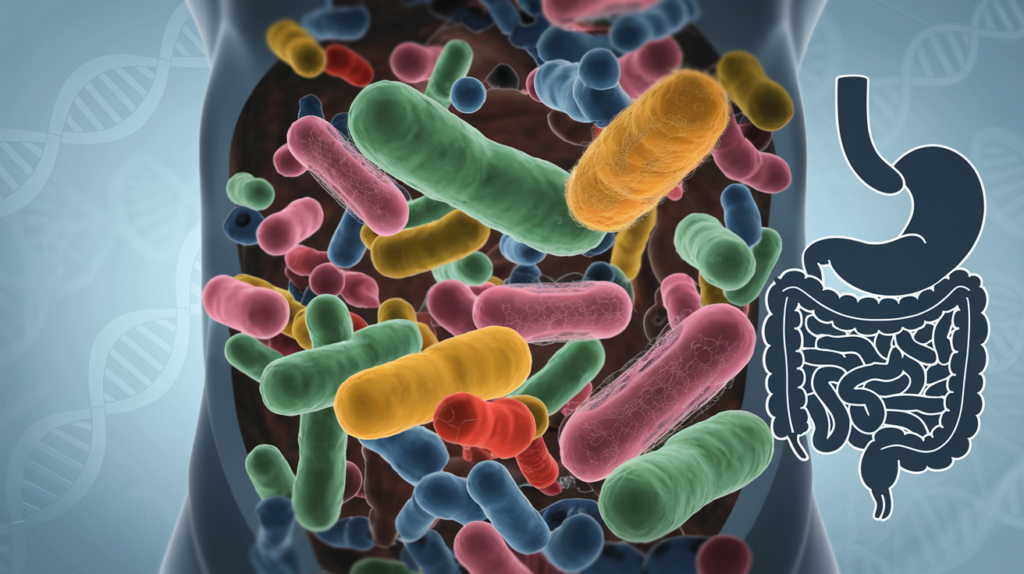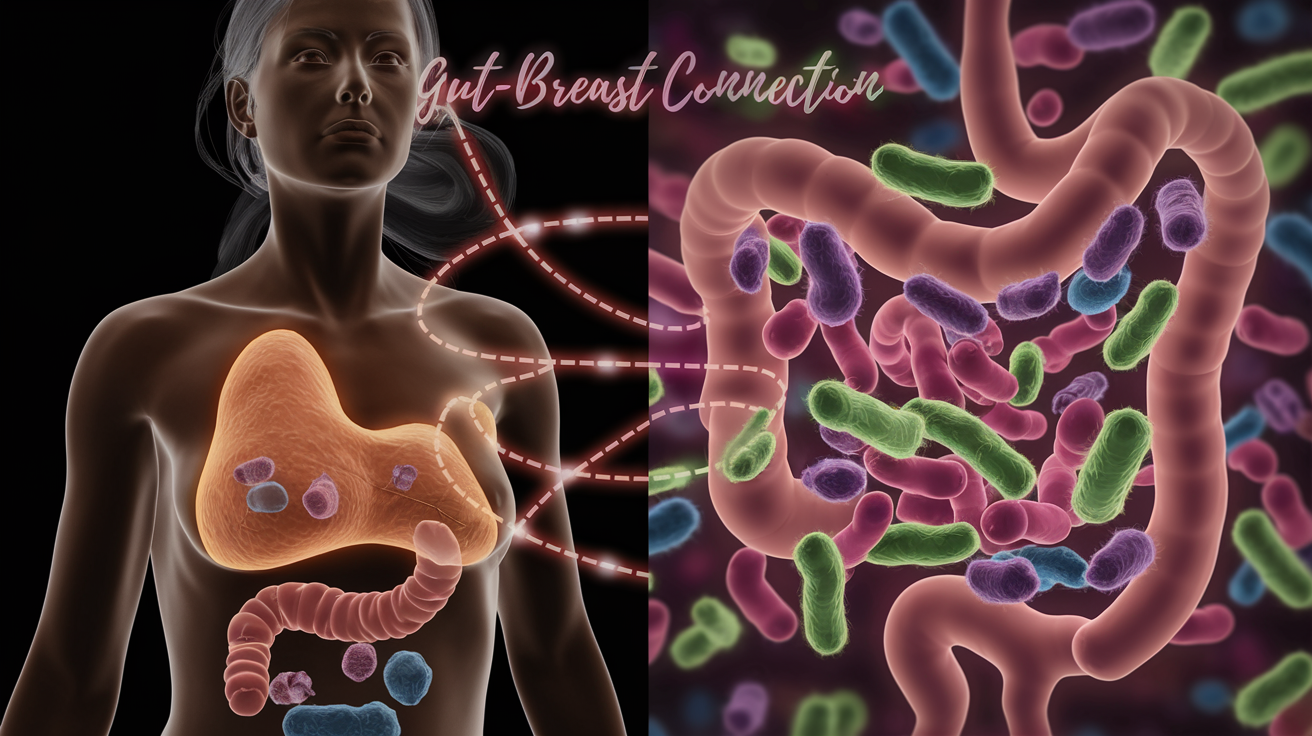This is part 1 of a 3-part series.
Table of Contents
Introduction
Breast cancer continues to be a significant global health concern, with recent data indicating a rising trend in both incidence and mortality rates. In 2022, approximately 2.3 million women worldwide were diagnosed with breast cancer, resulting in about 670,000 deaths. Projections suggest that by 2050, the annual number of new breast cancer cases will increase to 3.2 million, marking a 38% rise from current figures. Furthermore, annual deaths are expected to reach 1.1 million, representing a 68% increase.
Have you ever wondered how the trillions of tiny microorganisms living in your gut could be linked to your breast health? It might sound far-fetched, but recent scientific discoveries are unveiling an intriguing connection between your microbiome and breast cancer immunity. This hidden relationship could change how we approach breast cancer prevention and treatment.
Imagine if you could boost your body’s natural defences against breast cancer simply by nurturing the right balance of gut bacteria. It is cutting-edge science that is changing our understanding of cancer prevention and treatment. From influencing hormone levels to modulating our immune response, the microbiome is emerging as a powerful player in the fight against breast cancer.
In this article, we will delve into the gut-breast connection, exploring how our microscopic allies impact breast cancer immunity. We will uncover the mechanisms behind this intricate relationship, discuss factors that shape our microbiome, and look at new approaches to harnessing its power for cancer prevention and treatment.

Understanding the Microbiome
Definition and composition of the microbiome
The microbiome is a vast and complex ecosystem of microorganisms that inhabit your body, primarily residing in your gut. This intricate community consists of trillions of bacteria, viruses, fungi, and other microscopic organisms that coexist with you, playing roles in your overall health and well-being.
Each type of microorganism has its own unique function, contributing to the overall balance and health of your system. The composition of your microbiome is as unique as your fingerprint, influenced by factors such as:
- Genetics
- Diet
- Environment
- Lifestyle choices
- Medications (especially antibiotics)
To give you a clearer picture of the microbiome’s composition, let us break it down:
| Microorganism Type | Estimated Percentage | Examples |
| Bacteria | 90-95% | Firmicutes, Bacteroidetes |
| Viruses | 5-8% | Bacteriophages, Eukaryotic viruses |
| Fungi | 0.1-1% | Candida, Saccharomyces |
| Archaea | <1% | Methanobrevibacter smithii |
| Protozoa | <0.1% | Blastocystis, Entamoeba |
It is important to note that while bacteria make up the majority of your microbiome, the other components play equally significant roles in maintaining your health and influencing various bodily functions.
Key functions of gut microbiota
Your gut microbiota, which refers specifically to the microorganisms in your intestinal tract, performs a myriad of essential functions that impact your overall health. Understanding these functions is crucial in comprehending how the microbiome influences breast cancer immunity and other aspects of your well-being.
- Nutrient metabolism and absorption
- Your gut bacteria help break down complex carbohydrates that your body cannot digest on its own.
- They produce essential vitamins like B12, K, and folate.
- They aid in the absorption of minerals such as calcium, magnesium, and iron.
- Immune system regulation
- Gut microbiota trains and modulates your immune system, helping it distinguish between harmful pathogens and beneficial microorganisms.
- It produces antimicrobial compounds that protect against harmful bacteria.
- It maintains the integrity of your gut barrier, preventing the entry of pathogens into your bloodstream.
- Inflammation control
- Certain gut bacteria produce anti-inflammatory compounds that help regulate your body’s inflammatory responses.
- They can influence the production of cytokines, which are crucial in immune system signalling.
- Hormone regulation
- Your gut microbiota influences the production and regulation of various hormones, including those that affect your mood, appetite, and metabolism.
- Protection against pathogens
- Beneficial bacteria compete with harmful pathogens for resources and space, helping to prevent infections.
- They produce substances that inhibit the growth of pathogenic bacteria.
- Brain-gut communication
- Your gut microbiota plays a role in the gut-brain axis, influencing your mood, behavior, and cognitive function.
- It produces neurotransmitters like serotonin, which affects your mental health.
- Metabolism of drugs and toxins
- Some gut bacteria can metabolise drugs and environmental toxins, potentially affecting their efficacy or toxicity.
Understanding these functions highlights the far-reaching impact of your gut microbiota on your overall health, including its potential influence on breast cancer immunity. By maintaining a healthy and diverse microbiome, you are supporting not just your digestive health, but your entire body’s well-being.
The Gut-Breast Axis Explained
The gut-breast axis is a fascinating concept that highlights the intricate connection between your gut microbiome and breast health. This axis represents a complex interplay of various physiological systems, including your immune system, endocrine system, and metabolic pathways.
Here is how the gut-breast axis functions:
- Immune system modulation
- Your gut microbiome plays an important role in training and regulating your immune system.
- A healthy gut microbiome promotes a balanced immune response, which is essential for recognising and eliminating potential cancer cells in your breast tissue.
- Dysbiosis (an imbalance in gut bacteria) can lead to chronic inflammation, potentially increasing your risk of breast cancer.
- Oestrogen regulation
- Certain gut bacteria produce an enzyme called β-glucuronidase, which can reactivate oestrogen in your intestines.
- This reactivated oestrogen can be reabsorbed into your bloodstream, potentially influencing hormone-dependent breast cancers.
- A healthy gut microbiome helps maintain proper oestrogen metabolism and excretion.
- Production of beneficial metabolites
- Your gut bacteria produce short-chain fatty acids (SCFAs) like butyrate, propionate and acetate, and the metabolite cadavarine which have anti-inflammatory and anti-cancer, including inhibiting cancer cell proliferation and promoting apoptosis
- These metabolites can reach your breast tissue through the bloodstream, potentially offering protection against cancer development.
- Influence on obesity and metabolism
- Your gut microbiome affects how you metabolise nutrients and store fat.
- Obesity is a known risk factor for breast cancer, and maintaining a healthy gut microbiome can help in weight management.
- Detoxification processes
- Your gut microbiome aids in the breakdown and elimination of potentially harmful substances, including environmental toxins that may contribute to breast cancer risk.
To illustrate the gut-breast axis more clearly, consider the following table:
| Gut Microbiome Function | Impact on Breast Health |
| Immune regulation | Enhances cancer cell recognition and elimination |
| Oestrogen metabolism | Influences hormone-dependent breast cancer risk |
| SCFA production Cadavarine | Provides anti-inflammatory and anti-cancer effects |
| Metabolic regulation | Affects obesity, a breast cancer risk factor |
| Detoxification | Helps eliminate potential carcinogens |
Understanding the gut-breast axis opens up new possibilities for breast cancer prevention and treatment strategies. By focusing on maintaining a healthy gut microbiome, you may be able to positively influence your breast health and potentially reduce your risk of breast cancer.
As we go deeper into the relationship between the microbiome and breast cancer immunity, it is important to remember that this connection is bidirectional. Just as your gut health can influence your breast health, factors affecting your breast tissue can also impact your gut microbiome. This intricate relationship underscores the importance of a holistic approach to health, considering both gut and breast health as interconnected aspects of your overall well-being.
Now that you understand the basics of the microbiome and its connection to breast health, we will explore how specific imbalances in the gut microbiome can directly impact breast cancer immunity and risk factors.
Breast Cancer and the Immune System
Overview of breast cancer types
Breast cancer is not a single disease but rather a complex group of malignancies that can be classified into several distinct types. Understanding these types is crucial for developing effective treatment strategies and improving patient outcomes. Let’s explore the main categories of breast cancer:
- Invasive Ductal Carcinoma (IDC)
- Invasive Lobular Carcinoma (ILC)
- Ductal Carcinoma In Situ (DCIS)
- Inflammatory Breast Cancer (IBC)
- Triple-Negative Breast Cancer (TNBC)
- HER2-Positive Breast Cancer
Here is a breakdown of these breast cancer types and their key characteristics:
| Breast Cancer Type | Description | Prevalence | Prognosis |
| Invasive Ductal Carcinoma (IDC) | Starts in milk ducts and spreads to surrounding tissue | 70-80% of all breast cancers | Varies depending on stage and subtype |
| Invasive Lobular Carcinoma (ILC) | Begins in milk-producing lobules and invades nearby tissue | 10-15% of breast cancers | Generally good if caught early |
| Ductal Carcinoma In Situ (DCIS) | Non-invasive, confined to milk ducts | 20-25% of new breast cancer diagnoses | Excellent when treated early |
| Inflammatory Breast Cancer (IBC) | Rare, aggressive form that causes swelling and redness | 1-5% of breast cancers | Poor, often diagnosed at advanced stages |
| Triple-Negative Breast Cancer (TNBC) | Lacks oestrogen, progesterone receptors, and HER2 protein | 10-20% of breast cancers | More aggressive, limited treatment options |
| HER2-Positive Breast Cancer | Overexpression of HER2 protein | 20% of breast cancers | Historically aggressive, but targeted therapies have improved outcomes |
Understanding these different types of breast cancer is essential for both patients and healthcare providers. Each type may require a unique approach to treatment, and your immune system plays a crucial role in fighting these cancer cells.
The role of immunity in cancer prevention
Your immune system is your body’s natural defence against various threats, including cancer cells. It plays a vital role in preventing the development and spread of breast cancer. Here is how your immune system contributes to cancer prevention:
- Surveillance: Your immune cells constantly patrol your body, searching for abnormal cells that could potentially become cancerous.
- Recognition: When your immune system detects potentially harmful cells, it can identify them as threats based on specific markers or antigens on their surface.
- Elimination: Once recognised, your immune system can activate various mechanisms to destroy these abnormal cells before they develop into full-blown cancers.
- Memory: After encountering and eliminating cancer cells, your immune system can develop a “memory” of these threats, allowing for quicker and more effective responses in the future.
Your immune system’s cancer-fighting capabilities are primarily driven by:
- T cells: These specialised lymphocytes can directly attack cancer cells or coordinate other immune responses.
- Natural Killer (NK) cells: These cells can recognise and destroy cancer cells without prior sensitisation.
- Antibodies: Produced by B cells, antibodies can tag cancer cells for destruction by other immune cells.
- Macrophages: These cells engulf and digest cancer cells, as well as present antigens to other immune cells.
However, it is important to note that cancer cells can sometimes evade or suppress the immune system, allowing them to grow and spread. This is where understanding the relationship between your immune system and breast cancer becomes crucial for developing effective prevention and treatment strategies.
How the immune system fights cancer cells
Your immune system employs a variety of sophisticated mechanisms to combat cancer cells. This process, known as cancer immunosurveillance, involves several key steps:
- Detection: Your immune system first needs to recognise cancer cells as foreign or dangerous. This is often done through the identification of tumor-specific antigens or abnormal proteins on the cancer cell surface.
- Activation: Once a threat is detected, your immune system initiates a complex cascade of events to activate various immune cells.
- Attack: Activated immune cells then launch a coordinated assault on the cancer cells using different strategies:
- Cytotoxic T cells directly kill cancer cells by releasing toxic substances
- Natural Killer cells induce apoptosis (programmed cell death) in cancer cells
- Antibodies mark cancer cells for destruction by other immune cells
- Macrophages and neutrophils engulf and digest cancer cells
- Regulation: Your immune system also includes regulatory mechanisms to prevent excessive inflammation and autoimmune reactions.
Here is a tabled look at how specific immune cells target breast cancer:
| Immune Cell Type | Role in Fighting Breast Cancer |
| Cytotoxic T cells | Directly kill cancer cells by releasing perforin and granzymes. Perforin and granzymes are cytotoxic proteins used by immune cells, particularly cytotoxic T lymphocytes (CTLs) and natural killer (NK) cells, to eliminate virus-infected or cancerous cells. |
| Helper T cells | Coordinate immune responses and activate other immune cells |
| B cells | Produce antibodies that tag cancer cells for destruction |
| Natural Killer cells | Recognise and destroy cancer cells without prior sensitisation |
| Dendritic cells | Present cancer antigens to T cells, initiating adaptive immune responses |
| Macrophages | Engulf cancer cells and present antigens to other immune cells |
Despite these powerful mechanisms, cancer cells can develop ways to evade or suppress the immune system. Some strategies used by breast cancer cells include:
- Downregulating tumour antigens to avoid detection
- Expressing immune-inhibitory molecules that deactivate immune cells
- Recruiting regulatory T cells that suppress anti-tumor immune responses
- Altering the tumour microenvironment to become immunosuppressive
Understanding these evasion tactics has led to the development of innovative immunotherapy approaches for breast cancer treatment.
Immunotherapy in breast cancer treatment
Immunotherapy has emerged as a promising avenue for breast cancer treatment, particularly for certain subtypes that have historically been challenging to treat. This approach aims to harness and enhance your body’s natural immune defences against cancer cells. Here are some key immunotherapy strategies being used or investigated for breast cancer:
- Checkpoint Inhibitors: These drugs block proteins that prevent T cells from attacking cancer cells. Examples include:
- PD-1/PD-L1 inhibitors (e.g., pembrolizumab, atezolizumab)
- CTLA-4 inhibitors (e.g., ipilimumab)
- Monoclonal Antibodies: These lab-created antibodies target specific proteins on cancer cells. Examples include:
- Trastuzumab (Herceptin) for HER2-positive breast cancer
- Pertuzumab (Perjeta) often used in combination with trastuzumab
- Adoptive Cell Therapy: This involves removing immune cells from a patient, modifying them to better target cancer cells, and then reinfusing them. CAR-T cell therapy is an example of this approach.
- Cancer Vaccines: These vaccines stimulate the immune system to recognise and attack specific cancer antigens. While still largely experimental for breast cancer, they show promise in clinical trials.
- Cytokines: These proteins can stimulate immune responses. Interleukin-2 (IL-2) and interferon are examples used in some cancer treatments.
The effectiveness of immunotherapy can vary depending on the breast cancer subtype and individual patient factors. Here is a brief overview of immunotherapy responses in different breast cancer types:
| Breast Cancer Type | Immunotherapy Response |
| Triple-Negative Breast Cancer | Generally more responsive to checkpoint inhibitors |
| HER2-Positive Breast Cancer | Targeted antibodies like trastuzumab are standard treatment |
| Hormone Receptor-Positive Breast Cancer | Less responsive to current immunotherapies, research ongoing |
While immunotherapy has shown remarkable success in some breast cancer cases, it is important to note that not all patients respond equally. Ongoing research is focused on identifying biomarkers that can predict immunotherapy response and developing combination therapies to enhance efficacy.
As we have explored the intricate relationship between breast cancer and the immune system, it is clear that your body’s natural defences play a role in both preventing and fighting this disease. Understanding these mechanisms not only helps in developing more effective treatments but also emphasises the importance of maintaining a healthy immune system. With this knowledge, we can now go into how the microbiome, particularly the gut microbiome, influences these immune responses and potentially impacts breast cancer development and progression. (Part 2 ).
I will supply references at the end of part 3.




yPujIRX qbaDeUx TQYdqEW
Устали от пыли и беспорядка? Наша компания в Санкт-Петербурге предлагает профессиональные услуги по уборке для вашего дома и офиса. Мы применяем только экологически безопасные средства и гарантируем непревзойденный порядок! Заходите Уборка квартир клининговая компания По какой причине стоит выбрать нас? Быстрая и качественная работа, индивидуальный подход к каждому клиенту и конкурентные цены. Поручите клининг профессионалам и получайте удовольствие от свежести без лишних хлопот!
Лучшие модели дизайнерской мебели премиум-класса.
Мебель премиум-класса [url=https://www.byfurniture.by]https://www.byfurniture.by[/url] .
Разыскиваете проверенную помощь в уборке вашей в Санкт-Петербурге? Наша группа профессионалов гарантирует чистоту и порядок в вашем доме! Мы применяем только безопасные и действенные средства, чтобы вы могли наслаждаться свежестью без хлопот. Жмите https://chisto-v-srok.ru/
Измучились от скучных уборок и бесконечной пыли? Наша компания в Санкт-Петербурге предлагает первоклассные услуги по уборке жилых так и деловых помещений. Мы заботимся о вашем времени, применяя только экологически чистые и действенные средства. Наша команда профессионалов наполнит вашему дому или офису сиянием и порядок, а вам — уверенность и спокойствие. Кликайте Комплексная уборка квартир Доверьте уборку нам и радуйтесь мгновениям, разделенным с семьей и приятелями! Запишитесь на безвозмездную консультацию прямо сейчас и получите специальные предложения для новых клиентов. Чистота — это не просто работа, это наше призвание!
Разыскиваете проверенную помощь в уборке вашей в Санкт-Петербурге? Наша группа специалистов гарантирует чистоту и порядок в вашем доме! Мы используем только безопасные для здоровья и действенные средства, чтобы вы могли вкушать свежестью без хлопот. Нажимайте https://profuslugi24.ru Не прозевайте уникальную возможность сделать свою жизнь проще и удобнее.
Уютная обивка утратила былй лоск? Химчистка мебели на дому в СПб! Вернем диванам, креслам и коврам их истинную красоту. Экспертные средства и опытные мастера. Бонусы новобранцам! Детали ждут вас! Тапайте https://himchistka-divanov-spb24.ru
Выездная химчистка в СПб и ЛО! Мягкая мебель, ковры, удобные сиденья – вернём чистоту и свежести прямо у вас дома! Звоните! Перемещайтесь к https://himchistka-spb24.ru